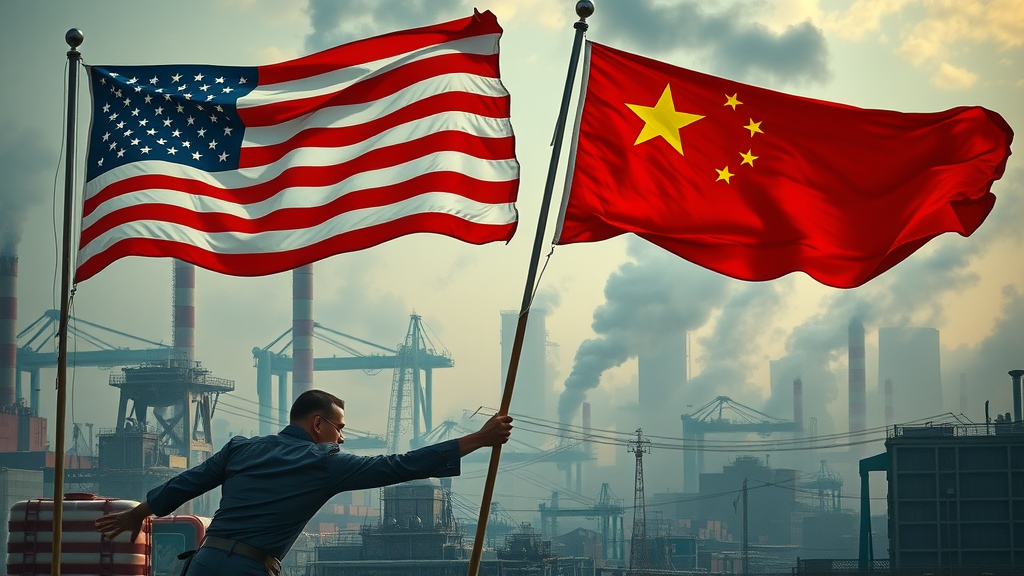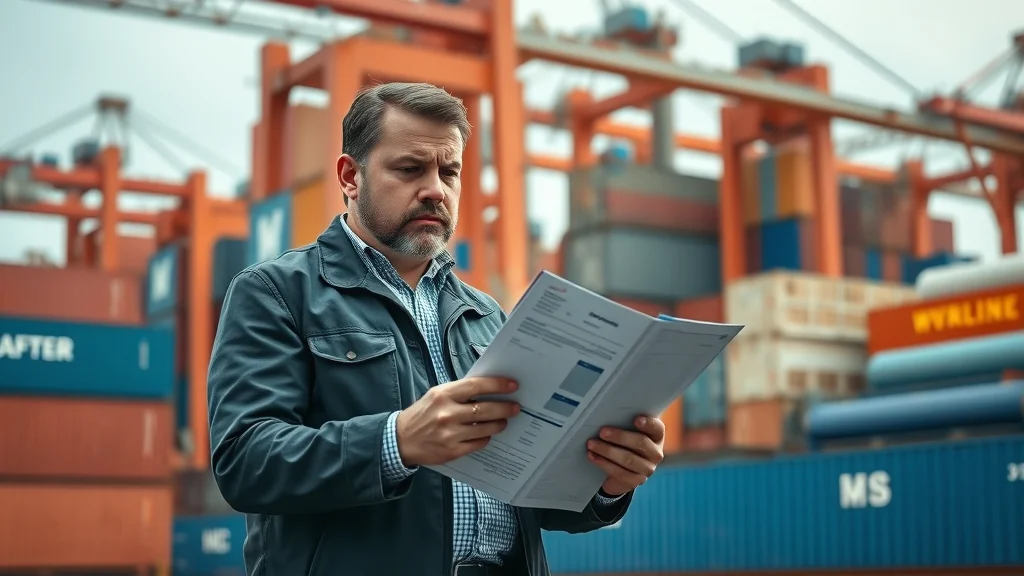Did you know that U.S. tariffs on Chinese products raised costs for American businesses by more than $57 billion in a single year, according to economic research? This shocking number underscores a critical truth: trade tariffs effects reach far beyond international negotiations and headlines. They influence every corner of the global supply chain, shifting prices, profits, and strategies for manufacturers and consumers alike. In this article, we’ll strip away the misconceptions and reveal what most people—and even many experts—miss about how tariffs really shape our economic world.
A Startling Truth: Trade Tariffs Effects Unveiled
Many view trade tariffs effects only through the lens of global politics or ongoing trade wars. However, the true impact is multifaceted, touching nearly every industry and influencing everyday life in unexpected ways. For U.S. manufacturers, an imposed tariff often means more than just a higher price tag—it can restructure entire markets, upend traditional supply chains, and demand rapid changes in business strategy. Recent shifts in trade policy have shown that even minor changes in tariff rates can ripple through the global economy, affecting not only the cost of imported goods but also determining the fate of domestic and export-focused industries.
Consider this: when the U.S. government implemented higher tariffs during the Trump administration, the Federal Reserve closely monitored the increase in consumer price and the resulting inflation. These economic effects were evident from the cost of steel in American factories to the sticker price of electronics in local stores. Despite the intended goals of boosting U.S. manufacturing, the effects of tariffs often produced both winners and losers, fundamentally altering the rules of global trade. This article dives into the surprising and less understood ways these effects unfold, especially for manufacturers navigating today’s volatile market.

The Unseen Economic Effects of Trade Tariffs
On the surface, tariffs seem like tools to balance the scales for domestic industries. Look deeper, and you’ll discover their unintended consequences—devastating supply chain disruptions, sudden swings in profit margins, and changes to the competitive landscape. As companies adapt, many are forced to raise consumer prices or absorb the costs themselves, leading to lower investment and even job losses. Meanwhile, unexpected winners can emerge in countries previously peripheral to global supply chains, as businesses seek alternatives to higher-tariff regions.
Beyond this, effective tariff calculations—factoring in exceptions, quotas, and exemptions—often mean the final impact on specific goods and sectors is quite different from “headline” rates. This complexity highlights why policy changes can produce economic effects that are hard to predict and harder to manage. Understanding this hidden layer is crucial not only for business leaders and policymakers but also for anyone affected by shifts in the cost and availability of everyday goods. The real story of trade tariffs effects is one of surprise, adjustment, and constant adaptation on a global scale.
Why Manufacturers Should Rethink Trade Policy Decisions
With trade policy shifts now common, manufacturers must constantly reassess their production and sourcing strategies. What worked yesterday may no longer make sense if a sudden tariff rate hike changes relative costs overnight. This uncertainty can impact long-term planning, forcing businesses to invest more in resilience—such as by diversifying supply chains, renegotiating supplier contracts, or even reshore production back to the United States. These moves can protect against additional trade war escalations, but also introduce complexity and transitional costs that eat into margins.
Moreover, tariff increases can have a disproportionate effect based on company size and sector. Small and midsize manufacturers, with fewer resources to absorb price increases or pivot suppliers, are often hit harder than multinational corporations. Understanding the difference between intended and real-world trade tariffs effects becomes an operational necessity—ignore it, and your competition could quickly leave you behind in the globally connected marketplace.
-
What You’ll Learn
- How trade tariffs effects ripple through the global economy
- Ways trade tariffs influence manufacturing, exports, and imports
- Differentiation between intended and unintended economic effects
- Insights into the real impact of tariffs on consumers and businesses
Understanding Trade Tariffs Effects in the Modern Economy
To truly understand trade tariffs effects, you must first grasp the mechanisms behind them. Tariff rates come in many forms, including broad import duties and targeted tariffs aimed at specific goods. While policymakers tout these measures for protecting domestic jobs or retaliating during a trade war, the chain reaction they unleash can be overwhelming and hard to reverse. In today’s economy, dominated by elaborate supply chains and fast-moving capital, even a small shift in tariff policy can alter the trajectory of global growth.
Recent history has demonstrated that the United States, European Union, and other major players often adapt their own rules in response to rivals, creating a volatile landscape. For manufacturers, understanding how tariff increases translate into effective changes at the most granular level—along individual steps of the supply chain or specific imported goods—is not optional. It is essential. Every change in the tariff rate can add up through production networks, causing cascading effects that are felt far from the original point of policy change.
Definitions: Tariff Rate, Effective Tariff, and Trade War
A tariff rate is the official tax placed on an imported good, typically expressed as a percentage of its value. The effective tariff, meanwhile, is the average rate companies actually pay, factoring in exemptions and trade deals. A trade war refers to escalating rounds of tariff and trade restrictions between two or more countries, usually resulting in higher costs for businesses and consumers. Each of these has nuance: a 10% increase in a headline tariff rate may sound dramatic, but exclusion lists, quotas, and phased implementation can soften—or worsen—the real economic effects on various sectors.
Crucially, the effective tariff is what truly matters for manufacturers, as it determines how much extra cost they’ll face and how much room they have to absorb, pass along, or avoid those costs. As trade wars become more frequent and complex, understanding these differences is pivotal for building resilient and future-proof manufacturing strategies.

A Brief History of United States Trade Policy & Tariff Rates
The history of United States trade policy has been marked by cycles of protectionism and liberalization. In the late 19th and early 20th centuries, high tariff rates were common, intended to nurture domestic industries against foreign competition. The early 1930s saw infamous spikes like the Smoot-Hawley Tariff, which many economists blame for deepening the Great Depression’s global economic effects. Post-World War II, multilateral trade agreements and organizations like the WTO ushered in a period of reductions in tariffs and robust global trade expansion.
The pendulum shifted again in the modern era, with the Trump administration’s aggressive tariff policies targeting diverse sectors from steel to semiconductors. This approach triggered retaliatory measures and ignited a trade war with China and other nations, demonstrating how shifts in tariff policy can swiftly reshape both domestic and global markets. Each phase of American tariff history underscores a central lesson: tariff decisions made in Washington, Brussels, or Beijing will always reverberate through every corner of the world’s interconnected economy.
| Era | Average Tariff Rate (%) | Economic Growth (Annual %) |
|---|---|---|
| 1890s | 29% | 2.2% |
| 1930s (Smoot-Hawley) | 46% | -1.2% |
| 1950s-1960s (Postwar Expansion) | 8% | 4.1% |
| 1980s-1990s (Trade Liberalization) | 4% | 3.2% |
| 2018-2020 (Modern Trade Wars) | 7-9% (select goods much higher) | 2.3% |

Presidential Impact: President Trump’s Tariff Policy Legacy
No recent figure has shaped the discourse around trade tariffs effects more than President Trump. His administration’s philosophy was unapologetically protectionist, explicitly using tariffs as leverage in international negotiations. Whether targeting steel, aluminum, or a vast array of Chinese consumer goods, Trump’s policies sparked a level of trade tension not seen since the mid-20th century. The results—intended and unintended—are still being tallied and will reverberate for years to come.
For many businesses, the lesson was clear: future-proofing against tariff shocks is no longer optional but an operational imperative. The domino effect triggered by tariff announcements, retaliations, and regulatory changes has permanently altered global supply chain sensibilities and business models.
President Trump and The U.S.-China Trade War

President Trump’s decision to raise tariffs on over $360 billion of Chinese imports marked a new era in the U.S.-China relationship. What began as a bid to protect U.S. intellectual property and narrow trade deficits quickly escalated into a prolonged trade war with global implications. Tariffs imposed by both nations led to immediate price increases on thousands of goods, while also triggering realignment in global trading patterns. Small- and medium-sized manufacturers in the United States, often reliant on components from China, suddenly faced extra costs or the challenge of sourcing alternatives from less dependable markets. At the same time, Chinese exporters lost crucial business, and global supply chains were forced to recalibrate—sometimes at great expense.
The broader economic effects were felt in stock markets, currency valuations, and even consumer prices within months of policy changes. The environmental consequences were also significant, with some supply chains shifting to regions with less robust sustainability standards, further complicating the calculus for responsible manufacturers and exporters.
“The effects of recent tariff policies are proving more persistent than many expected. Supply chains have adapted, but not always in ways that benefit consumers or boost efficiency.” — Dr. Elena Tsai, Trade Economist, World Markets Institute
Federal Reserve Perspective on Economic Effects and Tariff Revenue
The Federal Reserve has studied how trade tariffs effects ripple through the U.S. economy, focusing particularly on inflation, employment, and industrial output. Its research reveals that higher tariff rates almost always result in higher consumer prices—contrary to the notion that foreign exporters absorb most of the cost. In reality, businesses and American families pay more due to price increases on a wide array of imported goods, from household electronics to clothing.
At the same time, tariff revenue collected by the government has increased, providing a short-term fiscal boost. However, this comes with trade-offs: for every dollar collected, economists have found that costs passed on to businesses and consumers often outweigh the benefits several times over. This reinforces the importance of considering not just immediate tariff revenues, but the broader and often negative economic effects of such policy shifts on investment, jobs, and competitiveness.
Eight Crucial Effects of Tariffs Manufacturers Overlook
- Change in Consumer Price and Accessibility
- Shifts in Global Supply Chain Dynamics
- Impact on Effective Tariff Percentages
- Alterations in Manufacturer Profit Margins
- Adjustment in Tariff Revenue for Governments
- Potential Catalysts for Trade Wars
- Influence on United States & European Union Trade Relations
- Long-Term Economic Effects on Emerging Markets
Each item on this list represents a critical touchpoint in the web of trade tariffs effects. Whether it’s a price increase that hits consumers, a shift in where products are manufactured, or a new battleground for international negotiation, the impacts are far-ranging. For example, shifts in global supply chains following higher tariffs have led to a surge in reshoring efforts—bringing manufacturing back to the United States or moving it to lower-tariff countries. As a result, businesses must carefully track changes in effective tariff rates to remain competitive.
It’s also important to note that tariffs can become self-defeating. For governments, increased tariff revenue is quickly offset by broader economic costs, including retaliation from trade partners and reduced export opportunities for domestic businesses. Manufacturers who ignore these downstream effects do so at their own peril, especially as global supply chains become increasingly interconnected and responsive to even minor regulatory shifts.

Trade Tariffs Effects on U.S. Manufacturers and Exporters
For U.S. manufacturers, trade tariffs effects start with daily operational headaches, but extend all the way to strategic planning. Every time a new tariff is announced, companies must decide whether to absorb costs, pass them along, or seek alternative suppliers—each choice with its unique risks. The threat of sudden increases impacts not just pricing, but investment in equipment, hiring, and expansion plans, introducing real uncertainty into the business environment. Exporters, meanwhile, may see vital sales dry up overnight if trade partners impose retaliatory duties.
These risks are amplified for small and midsize companies, which often lack the clout to negotiate favorable terms or rapidly restructure supply chains. The repercussions extend to jobs, innovation, and global competitiveness, with the net result rarely aligning with the intentions of those who set tariff policy in the first place.
How Tariffs Influence Domestic Production and Export Capacity
Tariffs are commonly intended to boost domestic production by making foreign goods more expensive. While some U.S. producers benefit in heavily protected industries, others suffer from higher input costs and lost export opportunities. Consider a manufacturer assembling electronics: when the cost of imported components rises due to new duties, margins shrink, potentially leading to layoffs or decreased investment. Worse yet, retaliatory tariffs imposed by other countries can quickly shutter lucrative export markets, undermining the original policy objectives.
This dynamic creates a complex environment where manufacturers must balance the benefits of protection against the downsides of isolation. Often, net job gains are offset by losses in adjacent sectors, illustrating the interconnectedness of the modern manufacturing landscape and the wide-reaching effects of tariffs on every link in the U.S. industrial chain.

Supply Chain Reshoring: Risk or Opportunity?
The recent spike in tariffs has prompted a surge in “reshoring”—the practice of bringing manufacturing back from overseas. While this presents a unique opportunity for some industries to revitalize domestic jobs, it also exposes businesses to new risks, such as higher labor costs and gaps in local supplier capability. The decision to reshore is rarely simple: it requires weighing direct cost savings from avoiding higher tariffs against potential long-term inefficiencies or increased exposure to domestic economic fluctuations.
For some, reshoring can mean more reliable supply chains and quicker reaction times; for others, the transition period brings added expense and supply uncertainty. Regardless of approach, both risks and opportunities abound. Manufacturers who understand the nuances of effective tariffs are best positioned to capitalize as global trade patterns shift.

Why Understanding Effective Tariff is Critical for Modern Manufacturers
Every manufacturer must know their “effective tariff” exposure in real time. Unlike the headline tariff rate, the effective tariff accounts for sector-specific exemptions, special trade deals, and quotas that can dramatically change the final cost of inputs and finished goods. Mistaking the headline rate for the real-world impact can lead to disastrous business decisions—mispricing, cash flow shocks, or loss of market share to better-prepared rivals.
For example, a U.S. electronics manufacturer might face a 25% official tariff on a key component, only to discover that certain suppliers qualify for 10% rates under a new trade agreement. Failing to track or anticipate these changes could mean enduring higher prices needlessly. Staying informed and agile is essential to maintain competitiveness in markets shaped daily by evolving tariff policies and global negotiations.
The International Reach: Economic Effects on the European Union and Beyond
Though much of the discussion around trade tariffs effects focuses on U.S.-China relations, the consequences extend to the European Union and global markets. EU policymakers have had to swiftly recalibrate both strategy and regulations to counter shifting U.S. tariff rates, responding with their own countermeasures and trade partnerships. These realignments impact everything from agriculture export flows to advanced manufacturing, with downstream effects on jobs and consumer prices across the continent.
Global businesses operating within or trading with the EU face a complex, fast-changing environment fueled by competing priorities: protecting domestic jobs, complying with sustainability standards, and maintaining export competitiveness despite ongoing trade policy shifts. This is the new normal, where the winners are those best equipped to adapt strategies at a moment’s notice.
European Union Policy Changes as a Reaction to U.S. Tariffs
The European Union has historically advocated for open markets and lower tariffs, but recent years have demanded a more defensive stance. As the U.S. imposed new tariffs on key European exports—from automobiles to dairy products—the EU responded with its own selective barriers and aggressive pursuit of new trade agreements with Asia and Latin America. The intent was to balance the risk of losing access to lucrative American markets while protecting its own industries and jobs.
This evolving environment is forcing both EU manufacturers and their global partners to rethink sourcing strategies, investment priorities, and even R&D plans. As the EU continues to refine its response to shifting U.S. tariff policy, businesses must remain vigilant, understanding that today’s arrangement could change dramatically in response to the latest trade war escalation or diplomatic breakthrough.

Trade War Escalation: Winners, Losers, and Global Economic Shifts
Trade wars set off by tit-for-tat tariff increases often result in both winners and losers. Manufacturers in third-party countries sometimes see demand spike as traditional supply chains are disrupted, while exporters in targets of new tariffs scramble to adapt or risk losing vital revenues. One major effect is the acceleration of global economic shifts—emerging markets, for example, may benefit from production relocations as giants like the United States and China become less mutually dependent.
However, lasting prosperity is far from guaranteed. Higher tariffs, retaliatory measures, and erratic trade policy introduce volatility into the world economy. Investment slows as businesses hedge against future risk; meanwhile, consumers everywhere pay higher prices, even for goods seemingly unrelated to the trade dispute at hand. The unpredictable, far-reaching nature of these effects makes agility and strategic foresight more important than ever for manufacturers and global traders.

How Trade Tariffs Effects Alter Consumer Prices and Behaviors
The most tangible trade tariffs effects are often felt by ordinary consumers at the checkout counter. Even a modest increase in tariff rates can spark a chain reaction that ultimately results in higher consumer prices for everything from electronics to groceries. Manufacturers, hit with higher input costs, must choose between absorbing the squeeze or raising prices on finished products. As economic data shows, the burden typically falls to families and small businesses, who have the least power to avoid or mitigate cost surges.
But the impact isn’t limited to price tags. Shifting relative costs can change consumer behavior—encouraging more domestic purchases or, conversely, spurring demand for less expensive substitutes from new markets. This forces companies to rethink product strategies, marketing plans, and even global sourcing, underscoring the pervasive and dynamic nature of tariffs imposed in today’s trade environment.
The Link Between Tariff Rates and Domestic Consumer Prices
Study after study confirms a clear correlation: higher or more expansive tariffs raise domestic consumer prices. In practice, when a component or finished imported good faces a new duty, its price increases by nearly the full value of the tariff, because few businesses have wide enough margins to absorb such shocks. This predictable relationship means that the real cost of tariffs extends beyond balance sheets, directly influencing the affordability of daily life.
For example, a 20% tariff on household appliances imported from Europe or Asia will almost inevitably result in appliances on U.S. shelves costing an extra 20%—sometimes more if supply constraints or market uncertainty come into play. Meanwhile, businesses with global reach may offset some increases by revising contracts or leveraging alternative sources, but the final burden is largely borne by end consumers. This “invisible tax” is a central, often overlooked aspect of trade tariffs effects.
Unintended Consequences: The Hidden Costs on Everyday Goods
It’s easy to overlook the hidden costs of tariffs that ripple beyond product price tags. When companies must redesign supply chains or shift to less efficient suppliers to avoid tariffs, they incur real economic losses—from higher logistics bills to delayed delivery schedules and lower quality. In aggregate, these changes can undermine consumer trust, erode brand loyalties, and drive up the price of seemingly unrelated goods through an economy-wide domino effect.
Worse, these subtle impacts tend to hit the most vulnerable hardest. Lower-income consumers, with a higher proportion of their budgets spent on essentials, are often affected most by price increases in food, clothing, or energy—sectors frequently targeted in trade disputes. Recognizing these side effects is vital for fair, future-minded tariff policy and responsible business planning in a world where tariffs are increasingly common tools.
“Short-term sourcing changes to avoid tariffs saved us on paper, but long-term disruptions increased costs and made consistent supply a bigger challenge than ever.” — Julia Pearson, VP Supply Chain, American Electronics Manufacturer
Case Studies: Real-World Impacts from Recent Trade Tariffs
An American Electronics Manufacturer’s Perspective
For one mid-sized electronics company based in Ohio, the onset of new China tariffs meant immediate price hikes on critical circuit board components. The result? Not only did production costs jump by over 15%, but several longstanding supplier relationships had to be abandoned, disrupting timelines and product quality. Retaliatory tariffs on U.S. exports also led to lost contracts overseas—a double challenge that forced painful adjustments, layoffs, and the shelving of new project plans. This story is far from unusual: in survey after survey, American manufacturers recount similar trade tariffs effects across the supply chain.
Even those able to “pass through” some costs have seen customer resistance and competitive disadvantage versus foreign firms not subject to the same burdens. Over time, these cumulative disruptions threaten not only profits but long-term innovation and brand reputation, further highlighting why a nuanced understanding of trade policy is essential to business survival and growth.
The Role of Tariff Revenue in Federal Policy Adjustments
The increased tariff revenues collected in recent years have offered a tempting financial cushion for government budgets. However, these short-term gains often mask broader harms to investment and consumer spending, according to experts at the Federal Reserve and leading think tanks. The tradeoff is clear: for every additional dollar in tariff revenue, families and businesses stand to lose several dollars in purchasing power or direct economic opportunity. In a global marketplace, where trust and efficiency determine long-term success, the true legacy of modern tariff policies will be written in the aggregate well-being of businesses and the communities they support.
Policymakers tracking effective tariff rates and their real-world impacts must keep this balance top of mind when making key decisions on future trade agreements, exemptions, or escalation strategies.
People Also Ask: Trade Tariffs Effects Demystified
What are the effects of tariffs on trade?
Answer: Tariffs restrict imports, alter prices, support domestic industries, and sometimes provoke retaliation, all of which are significant trade tariffs effects.
Will Trump tariffs cause inflation?
Answer: President Trump's tariffs increased the price of some goods and contributed to short-term inflation in certain sectors, demonstrating trade tariffs effects on consumer price.
What is Donald Trump's tariff policy?
Answer: Donald Trump's tariff policy emphasized protectionism, with increased tariffs on imports from China and other countries as a central feature, shaping modern trade tariffs effects.
What are the 8 effects of tariffs?
Answer: The eight effects include higher consumer prices, altered supply chains, changes to effective tariff rates, modifications in profit margins, increased tariff revenue, trade war risk, impacts on international relations, and shifts in global markets—all central trade tariffs effects.
FAQs: More on Trade Tariffs Effects
How does a change in tariff rate impact small and large manufacturers?
Changes in tariff rate can hit companies of all sizes, but small manufacturers often face bigger challenges. They have fewer resources to absorb cost increases or pivot to new suppliers, making them more vulnerable to sudden tariff increases. Large manufacturers, with global networks and stronger bargaining power, can sometimes offset the worst impacts, but even they risk long-term market losses and complex operational changes if shifts persist.
What is meant by effective tariff and why does it matter?
An effective tariff is the real average tariff a company or sector faces after accounting for all exemptions, quotas, and trade agreements. It matters because businesses make strategic plans based on these calculations, not just headline rates. Getting effective tariff assessments right helps manufacturers maintain profitability and outmaneuver competitors in fast-changing global markets.
How can manufacturers monitor and respond to evolving trade tariffs effects?
Manufacturers need real-time monitoring of trade negotiations, tariff schedules, and regulatory notices. Advanced analytics, trade consultants, and robust supplier networks help by providing early warnings and flexible sourcing options. Fast adaptation—both operationally and strategically—is key to minimizing the downsides and capitalizing on new opportunities as the global trade environment shifts.
Key Takeaways: Navigating Trade Tariffs Effects Effectively
- Track both headline and effective tariff rates; your true exposure might differ.
- Constantly reassess supply chain resilience—consider diversification and contingency planning.
- Evaluate reshoring opportunities but balance them against potential new risks.
- Engage expert advisors for up-to-date insights on fast-moving trade policy shifts.
- Communicate proactively with partners and customers about changes and updates.
Conclusion: Why Understanding Trade Tariffs Effects is Essential for Staying Competitive
Proactive awareness and adaptation to global trade dynamics give manufacturers a real edge—understanding trade tariffs effects is no longer optional, but a necessity to survive and thrive.
Stay Ahead of Trade Tariffs Effects: Subscribe to Global Trade News
Manufacturer don't miss out! Stay informed on global trade shifts—tariffs, reshoring, and supply chain updates could reshape your strategy. Subscribe to Global Trade News for the latest updates. Call 203-271-7991 today.
Trade tariffs have far-reaching implications that extend beyond international negotiations, affecting various sectors of the economy. To gain a deeper understanding of these impacts, consider the following authoritative resources:
-
The Federal Reserve’s article, “Trade-offs of Higher U.S. Tariffs: GDP, Revenues, and the Trade Deficit,” provides an in-depth analysis of how increased tariffs influence GDP, government revenues, and trade balances.
-
The San Francisco Federal Reserve’s publication, “The Effects of Tariffs on Inflation and Production Costs,” examines the relationship between tariffs, inflation rates, and the cost structures within industries.
These resources offer valuable insights into the multifaceted effects of trade tariffs, enhancing your comprehension of their role in shaping economic dynamics.
 Add Row
Add Row  Add
Add 




Write A Comment